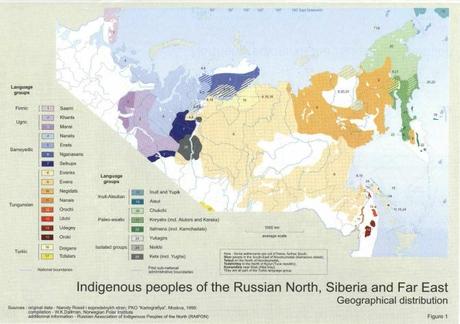In 1917, Berthold Laufter published an American Anthropologist article that traced the origins of the term “shaman” and concluded:
There could never be a serious doubt of the real source from which the word “shaman” is derived. We received it from the Russians: it was the Russian (chiefly Cossack) explorers and conquerors of eastern Siberia in the second half of the seventeenth century, who heard and recorded the term among Tungusian tribes.
“Shaman” had its origin in the Tungusian languages, in all of which the word indeed is known as šaman or saman, and with several other variations to be noted hereafter. It would be reasonable to regard the term as of native origin, for it is not likely that the name of a religious institution and function so characteristic of all the tribes of northern Asia should be borrowed from an outside quarter.
While I’ve long known about these Siberian origins, my knowledge of Siberian natives and ethnography has for too long been deficient. In an effort to remedy this and get some historical background on the available materials, I just read A History of the Peoples of Siberia: Russia’s North Asian Colony 1581-1990 by James Forsyth. It filled an enormous gap in my thinking about the peopling and habitation of the world.
Siberia, in my previously impoverished imagination, has long been a vast and mostly unpeopled wilderness. My view of Siberia, in other words, had much in common with the mythical view that European colonizers (and their descendants) had of the Americas: a vast, untamed “wilderness” that was only sparsely populated by natives. The corollary, of course, is that this was “unproductive” land ripe for settlement, farming, herding, and resource extraction. For this reason alone, I should have suspected I was wrong. And I was.
Given its vastness, it’s not surprising to learn that Siberia is ecologically and climatically diverse. It’s also not surprising to learn that it has long been inhabited by humans. While Siberian archeology gives us some sense of occupational time depth going back many thousands of years, most of what we know about the highly diverse groups of Siberian indigenes comes from Russian (and later, Soviet) sources. Unfortunately, few of these have been translated.
Perhaps the biggest surprise for me was learning that the Russians, beginning in the 16th century, embarked upon an age of exploration, conquest, and colonization in parallel with other European powers. The biggest difference was the Russians were doing it on land, whereas the other powers were doing it by sea. Another difference, remedied in part by Forsyth’s history, is that there are countless books on European exploration and colonization, whereas there are none (in English at least) on Russia’s conquest of Siberia. It is my understanding there is a large Russian-Soviet historical literature that recounts the epic scale and scope of these “heroic” endeavors, just as there is for other European colonial powers. Russia has its own versions of Columbus and Cortez.
As might be imagined, Russia’s centuries-long conquest and colonization of Siberia had devastating impacts on the native peoples and their traditional lifeways. There are many familiar and depressing parallels between what happened in the Americas and Siberia. These are things we need to keep in mind when considering the ethnographic literature on Siberian natives and “shamanism.”


